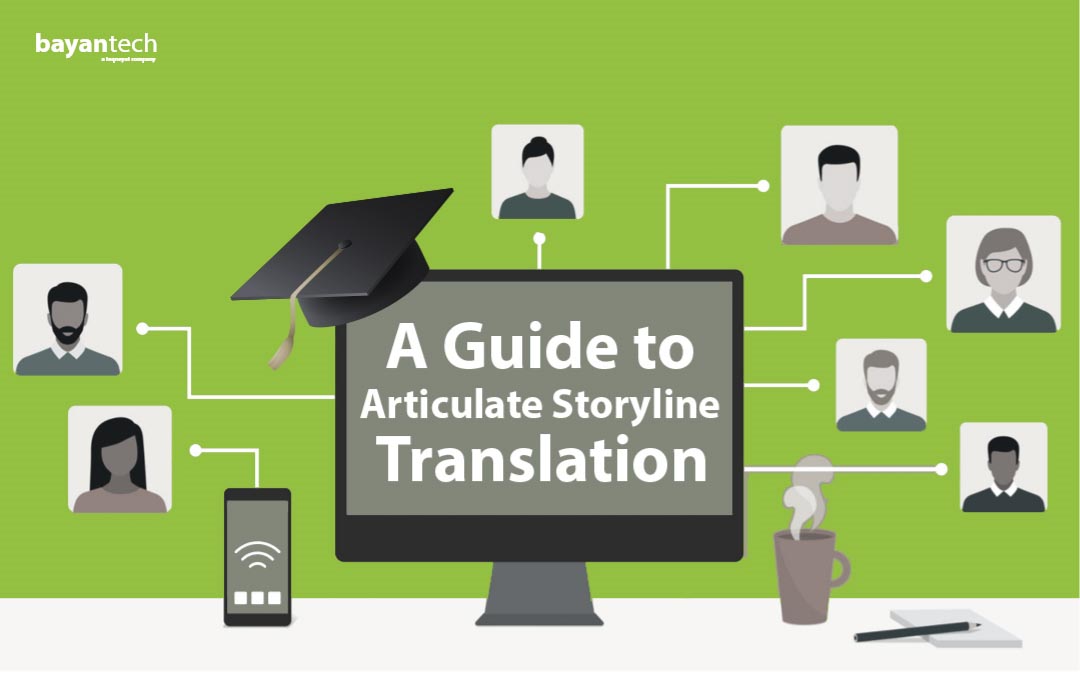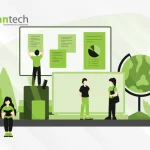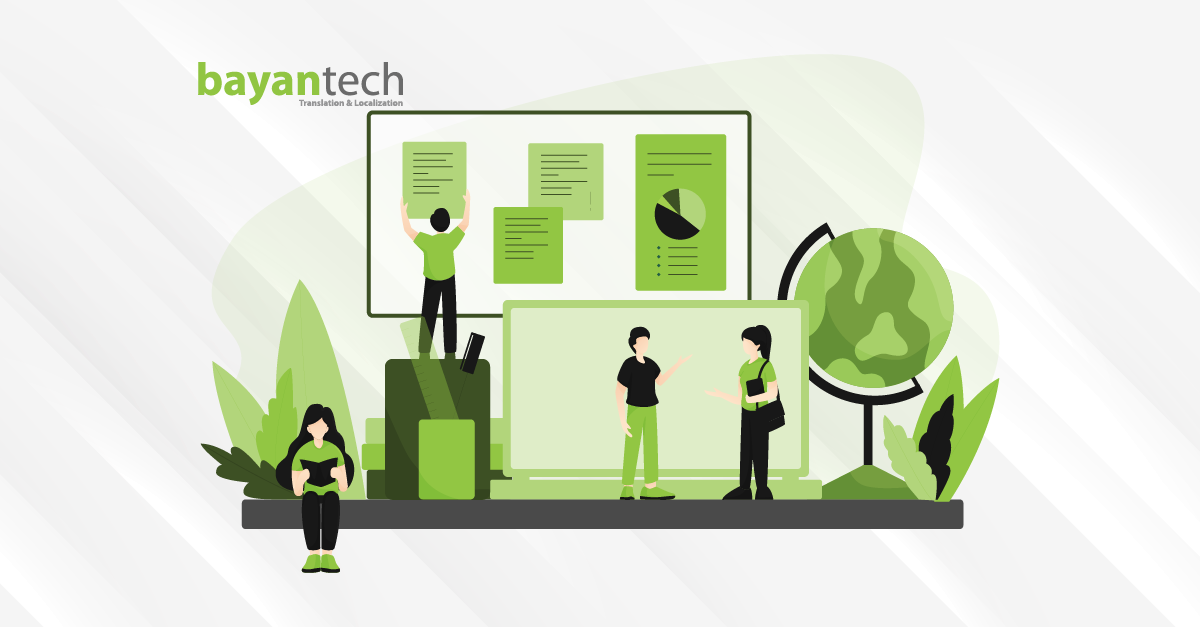eLearning courses are often praised as the synonym of dynamic, cost-effective training. But, in multicultural settings, your cross-cultural communication strategy can nullify or maximize the benefits of eLearning.
There are solid reasons why you should translate your eLearning content. For multinational businesses, accurately translating training material means guaranteeing a high-performance standard across the globe. On the other hand, only 25.9% of internet users speak English. So, if you run an eLearning business, by translating your eLearning course into a foreign language, you’re significantly increasing your potential outreach, thus increasing your business’ potential for expansion.

In this post, we’ll go over the definition of eLearning translation and some common eLearning translation challenges. We’ll also explain how to perform proper eLearning translation on one of the most popular eLearning authoring tools out there: Articulate 360’s Storyline.
Looking for a crash course in Storyline translation? You’ve come to the right place. Let’s get started.
Table of contents
- 1. eLearning Translation
- 2. The Limits of eLearning Translation
- 3. What’s an eLearning Authoring Tool?
- 4. What’s Articulate Storyline?
- 5. Why Is Storyline an Industry Favorite?
- 6. Storyline Translation in 4 Steps
- 7. How to Subtitle Audiovisual Material on Storyline
- 8. The Limits of Storyline translation
- 9. Do You Need Professional eLearning Translation Services?
eLearning Translation
Multilingual training environments pose new challenges to eLearning course creators, regardless of whether their eLearning courses are training material for a company’s new employees or scalable digital products.
Like all types of translation, eLearning translation has its specific priorities, which are the consequence of the material’s goals. In the case of eLearning translation, translation services providers tend to prioritize:
The translated course material should be easy and enjoyable to read. Any examples or references that may not be culturally neutral should be replaced with more appropriate ones. And precise terminology usage should be prioritized since using the wrong terminology can severely downgrade the learning experience.
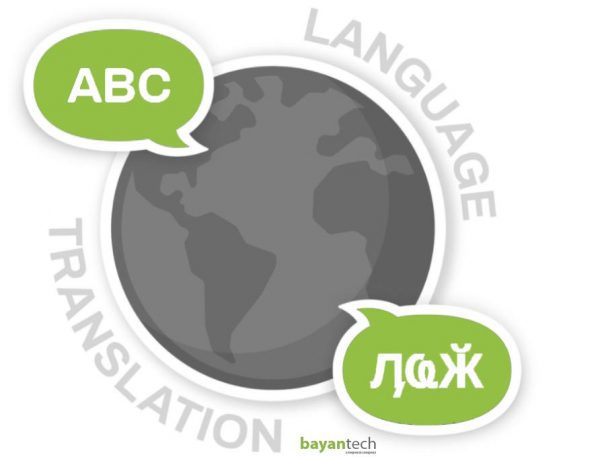
The Limits of eLearning Translation
Considering the aforementioned priorities, it’s clear that multilingual eLearning material should be translated by professional translators. A translator working on an eLearning course should have:
- High proficiency in both languages
- Insider knowledge into the source and target cultures
- Insider knowledge into the topic of the course
But eLearning translation is only half of the picture. When adapting eLearning courses for foreign students, you’ll need both translation and localization.
Translation consists of rendering a text into another language as faithfully and functionally as possible. The eLearning localization process, on the other hand, involves adapting all aspects of the material so it meets regulatory, cultural, functional, and technical standards.
For instance, translation involves making sure that every section is in the students’ preferred language and reads as clearly and evocatively as the original. Localization, on the other hand, involves replacing or modifying any images that may represent the students to make sure they match how the new students look. For instance, if you’re selling your course to a Japanese audience, you’ll want any images representing the students to be images of Japanese people.
If you’re adapting your course from English to Japanese, your content’s original layout may not accommodate your new text properly. In that case, localization will also involve slightly redesigning your course slides.
What’s an eLearning Authoring Tool?
Before we take a look at what Articulate Storyline is or how Storyline translation works, it’s worth taking a look at the category of computer programs it belongs to. Namely, eLearning authoring tools.
eLearning authoring tools are pieces of software designed to facilitate the development of eLearning courses.
There are several types of eLearning authoring tools. The most common are stand-alone tools, PowerPoint-based tools, and cloud-based and specialized tools.
Stand-alone tools were designed specifically to craft eLearning courses. They’re usually best suited for large eLearning departments creating content in a variety of formats. They’re also the ideal option for experts in need of considerable flexibility. If you need to build a course from the ground up and require as few restrictions as possible, there’s nothing like this type of tool.
In contrast, Microsoft PowerPoint-based tools are best for non-specialized and small teams, constrained by tight deadlines.

Web services are best for teams working remotely, or who need to collaborate on a file simultaneously. Its greatest downside tends to be pricing.
Highly-specialized tools, on the other hand, are tools that tackle a specific need of the eLearning course creation process. For instance, some tools are specifically designed to manage and edit interactive lectures.
As always, there’s no one-fits-all tool. Think about your needs, preferences, and resources, do your research, and let it guide you.
You may want your tool to support:
- Video functionalities such as tutorials or screencasts
- Interactive elements
- Branching scenarios
- Simulated dialogues
- A fully responsive and effective mobile experience
- eLearning translation and localization
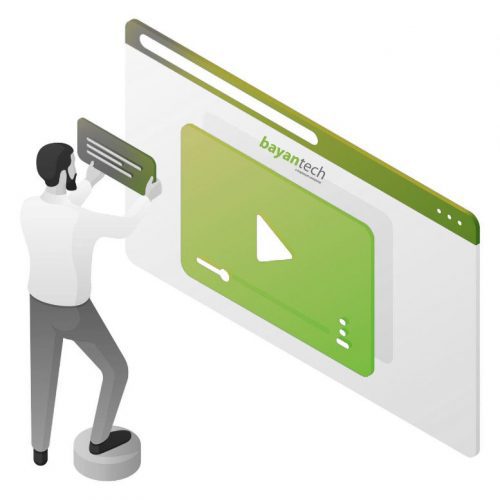
What’s Articulate Storyline?
Articulate Storyline is a standalone eLearning authoring tool that makes it possible for non-developers and non-designers to create interactive eLearning courses on computers and mobile devices alike.
Articulate Storyline 360 is the latest version of Articulate’s Storyline eLearning authoring tool.
Software like Storyline brings about real benefits for both companies crafting training material for internal use and solopreneurs developing eLearning products.
Are you working with Storyline for the first time?
We’ve created a resource for you. Check out our Storyline Translation
Step-by-Step Guide and streamline your process.
A company working with a beginner-friendly authoring tool such as Articulate Storyline can put the course development process in the hands of a team that specializes in the subject matter (HR, for instance), without involving other teams, who may be working to the top of their capacity.
Meanwhile, independent course creators with plenty of subject area knowledge but limited web development knowledge can use Storyline to craft minimum viable products (MVPs) and kickstart their eLearning businesses.
To access Articulate Storyline, users can either buy a one-time license for the product or subscribe to the Articulate 360 suite.
The Articulate 360 suite is a set of cloud-based eLearning authoring and publishing tools, including:
- Storyline 360
- Rise 360
- Content Library 360
- Review 360
This subscription also includes company-provided training and eLearning tips.
Sign up to our newsletter to receive the latest blogs and news.
Why Is Storyline an Industry Favorite?
Especially if you’re dissatisfied with your current eLearning authoring tool, you may be wondering why Storyline is often seen as the synonym of eLearning authoring. What makes it so special?
A reputable industry publication pointed out that the Storyline is a highly intuitive tool, developed by a reputable company, and with over 98,000 users under its belt. One of Storyline’s most robust features is that every course you create will be 100% responsive out of the box, regardless of the platform you’re working from.
It’s also worth mentioning that users working with the Articulate 360 suite have access to a vast library of audiovisual resources, as well as unbelievably extensive and detailed support documentation.
If you’re looking for an eLearning authoring tool, Storyline may be a solid choice for you, but don’t hesitate to evaluate other widely praised eLearning authoring tools.
We recommend:
- Adobe Captivate
- iSpring
- Koantic
- Lectora
- Elucidat
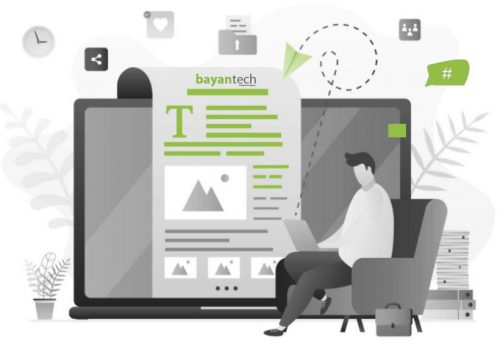
Storyline Translation in 4 Steps
Articulate Storyline 360 translation is easy. The process usually takes 4 steps.
1. Export the text in your preferred format
In Storyline, go to File > Translation, and pick your preferred format for exporting the text. You can select the best export format for your needs. Two common choices are:
- XLIFF: this file format is useful when working with translation management tools.
- Word: this format is best suited if you’re translating the content manually. It’s far more scannable for a non-expert than an XLIFF file.
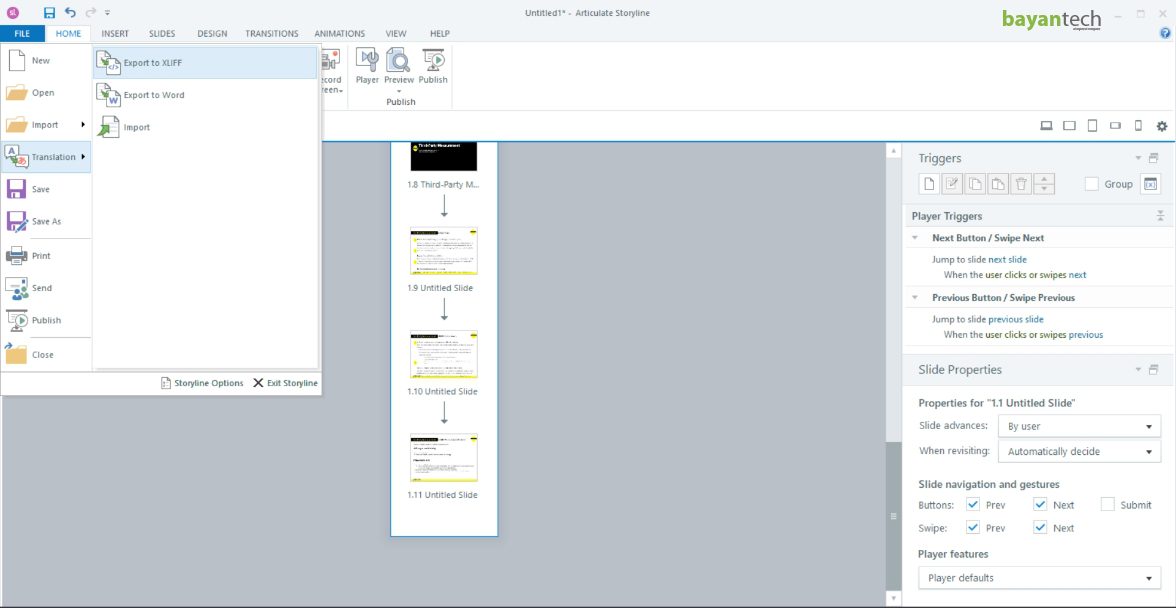
2. Translate the material
Articulate Storyline’s translation functionalities allow the user to import and export content but without translating it, so once you export the file, you’ll have to translate the text manually. While a machine translation service or tool such as Google Translate can make your work easier, the likeliness of a poor or inaccurate translation is high. At this point, your best choice is hiring an eLearning translation company.
But if you’re trying to carry out the task by yourself, take the following tips into account:
- Do not modify any text outside the column titled “Translate this Column”.
- Preserve the text formatting such as font, style, color, etc; since any change will also be reflected in your course when you import the file back to Storyline.
- You’ll need to translate closed captions and trigger conditions separately and then import the file back into Storyline since this process won’t work for them.
- This also applies to variable names as well as variable references. You need to translate both of them separately to ensure every variable reference matches with its corresponding variable name.
3. Import and proofread
Import the translated text to Storyline when it’s ready. To do so, create a copy of the original project so it can contain the new language. Then go to the File tab on Storyline, hover on Translation, and click Import. Browse for the Word or XLIFF file with the translated text and click Open. Once it’s imported, double-check your Storyline translation to make sure it fits the original layout, adjusting the text containers if any expansion took place.
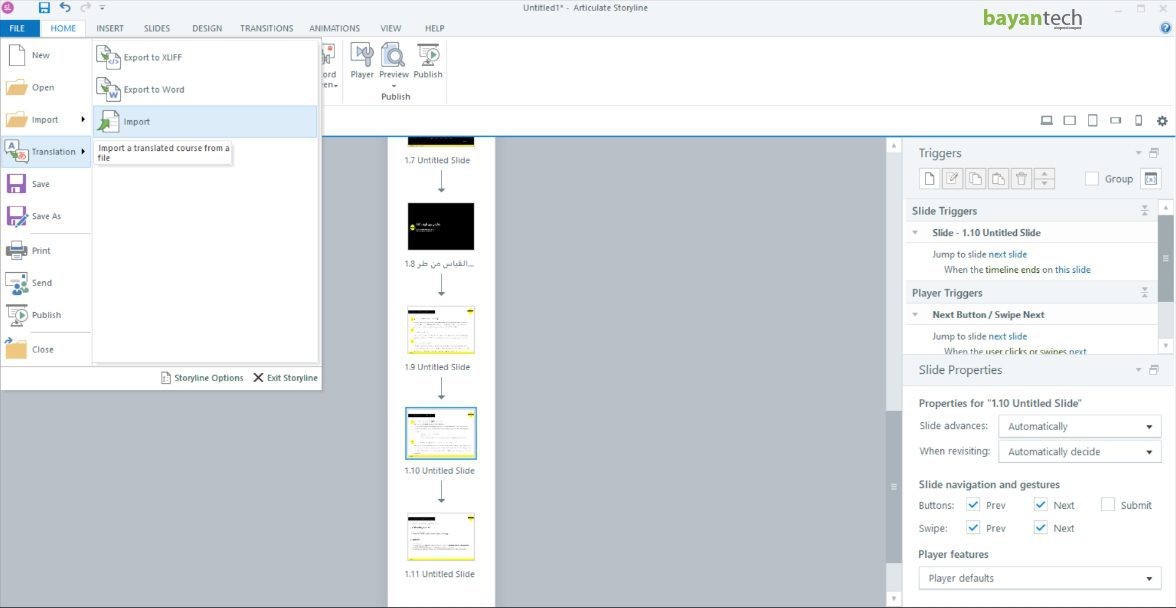
4. Localize
Before you save, make sure to properly adapt the buttons, images, and other elements of the interface for the target culture. You can’t have high-quality cross-cultural courses without any measure of eLearning localization.
How to Subtitle Audiovisual Material on Storyline
Adding captions in Articulate Storyline is as easy as Storyline translations.
Create caption boxes and add the content
First, insert a video in a blank slide. This is going to create caption boxes automatically by detecting peaks in the video’s audio waveforms. Next, fill in the boxes manually.
The audio waveforms detection can be a little inaccurate, so double-check the caption sync once you’ve filled the boxes.
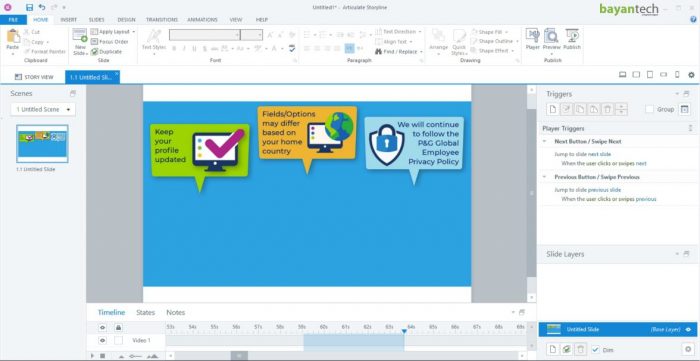
Adapt the boxes to the content
If the text ends up being too long, you can split the captions, trim, or add new boxes to make it fit. Each box will function as a clip you can play and repeat pressing Enter, and you can navigate through clips with Tab and Shift+Tab.
Of course, the Storyline interface makes captioning incredibly easy. But, can you translate into a foreign language by ear and create perfectly accurate captions? Having little experience in the field of subtitling will make this task tedious, and potentially inaccurate. With the help of a professional language services provider, you can ensure a top-quality experience in all your courses.
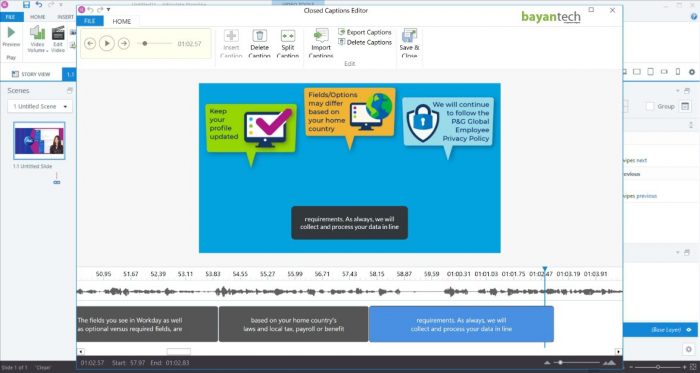
The Limits of Storyline Translation
Articulate Storyline courses can be easily translated through the aforementioned methods – or, better said, the translatable content can be easily extracted and replaced.
The translation itself has to be performed manually. In an ideal scenario, you are proficient in the required language pair and have no issues with your language hearing skills at the moment of captioning.
But the reality is often more complex: there may be technical nuances regarding the course content that complicate your translation process, and the lack of a methodical approach to translation may waste your time. Meanwhile, professional eLearning translators could deliver a flawless Articulate Storyline translation in half the time, for a price that will be a mere dent in your budget. For those who are learning with an online course, concept clarity means everything since your Storyline content may be their sole source of knowledge.
Don’t forget about localization. Having a fully functional Articulate Storyline translation may not suffice if the difference between your culture and that of your student is significant. In some cases, adapting icons, color palettes, and other elements of the material is not optional, but it’s the difference between a constructive learning experience and an offensive one.
As an eLearning course creator, you don’t need to be a cross-cultural expert. These important aspects of your material’s Articulate Storyline translation may be out of your specialty. And that’s absolutely fine. In this case, the best option is partnering up with an experienced and resourceful eLearning translation services provider.
Do You Need Professional eLearning Translation Services?
While Storyline translation is easy to implement, the software itself can’t produce a quality translation of your material. So, the most important step of the translation process is up to you.
You can either translate the material yourself or work with eLearning professionals who can craft a quality translation for you.
At bayantech, we’re a leading eLearning translation company with almost two decades of experience. As one of the MENA Region’s language services leaders, we combine cross-cultural expertise, skilled teams, and industry-leading tools to deliver excellent results at a competitive rate.

